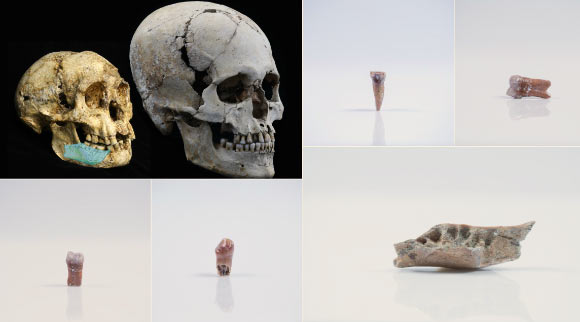New hominin fossils from the Indonesian island of Flores shed light on the origin of the mysterious ‘hobbit’ species, Homo floresiensis.

Hominin remains from Mata Menge. Upper left: Mata Menge jaw fragment overlayed over the LB1 skull of Homo floresiensis, next to modern human skull. Image credit: University of Wollongong.
An international team of scientists led by Dr. Gert van den Bergh from the University of Wollongong, Australia, excavated the hominin fossils — attributed to a population ancestral to Homo floresiensis — from layers of sedimentary rock at the early Middle Pleistocene site of Mata Menge in the So’a Basin of central Flores.
The specimens comprise a lower right jaw fragment and six isolated teeth belonging to at least three small-jawed and small-toothed individuals (one adult and two children).
The findings, published in two papers in the journal Nature (paper 1 & paper 2), detail the anatomical study of these fossils and show that the finds pre-date Homo floresiensis at Liang Bua by more than 500,000 years.
“Remarkably, these fossils, which include two milk teeth from children, are at least 700,000 year old,” Dr van den Bergh said.
“The finds have important implications for our understanding of early human dispersal and evolution in the region and quash once and for all any doubters that believe Homo floresiensis was merely a sick modern human (Homo sapiens).”
“All the fossils are indisputably hominin and they appear to be remarkably similar to those of Homo floresiensis,” added co-author Dr. Yousuke Kaifu from Tokyo’s National Museum of Nature and Science.
The morphology of the fossil teeth also suggests that this human lineage represents a dwarfed descendant of early Homo erectus that somehow got marooned on Flores.
“What is truly unexpected is that the size of the finds indicates that Homo floresiensis had already obtained its small size by at least 700,000 years ago,” Dr. Kaifu said.
Dr. van den Bergh added: “given stone artifacts uncovered from the same region date back to at least one million years ago, this insular human lineage had been present on Flores at least 300,000 years earlier.”
“It is conceivable that Homo floresiensis evolved its miniature body proportions during the initial 300,000 years on Flores, and is thus a dwarfed side lineage that ultimately derives from Homo erectus,” he said.
“It is also possible that this lineage pre-dates the first hominin arrival on Flores, implying speciation occurred on a stepping-stone island between Asia and Flores, such as Sulawesi.”
In January 2016 Dr. van den Bergh and co-authors published the occurrence of stone tools on Sulawesi that predate the arrival of modern humans on that island, and it is conceivable that these stone tools were made by another isolated hominin lineage that produced the offshoot that founded the lineage on Flores.
“The key to fully evaluating the finds now is the recovery of additional, more complete hominin skeletal remains from the proven deposits at Mata Menge, or from older fossil-bearing strata,” Dr. van den Bergh said.
_____
Gerrit D. van den Bergh et al. 2016. Homo floresiensis-like fossils from the early Middle Pleistocene of Flores. Nature 534, 245-248; doi: 10.1038/nature17999
Adam Brumm et al. 2016. Age and context of the oldest known hominin fossils from Flores. Nature 534, 249-253; doi: 10.1038/nature17663







